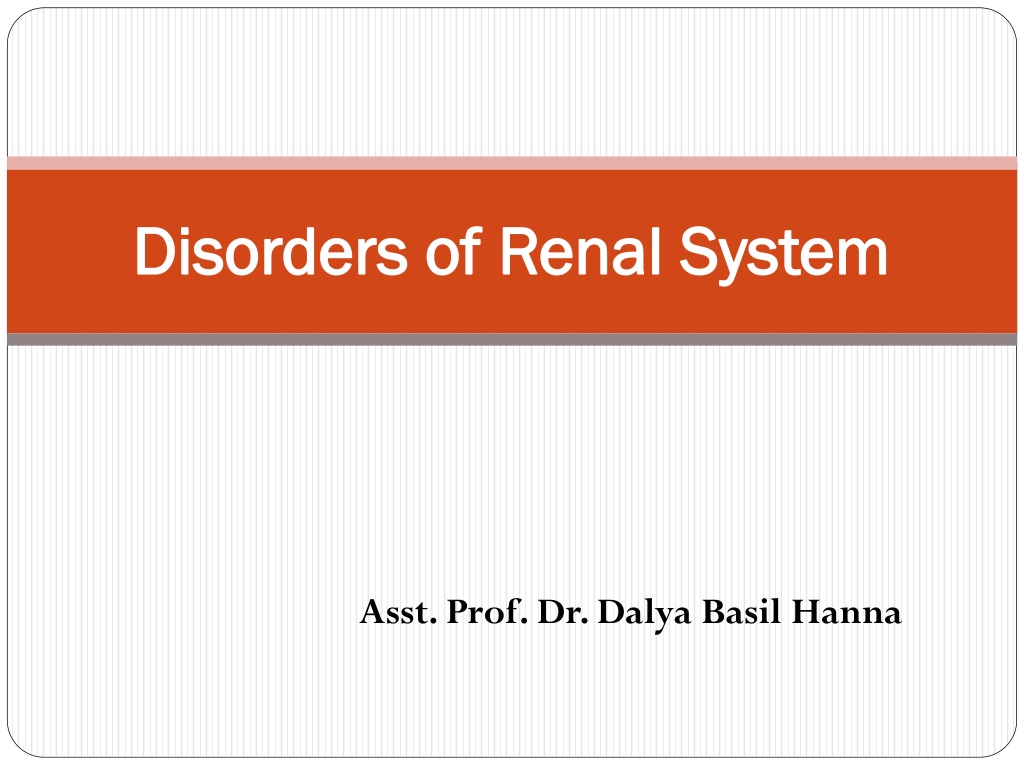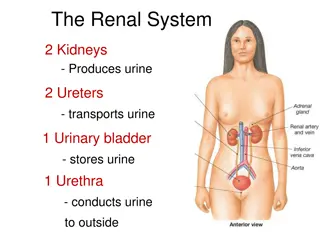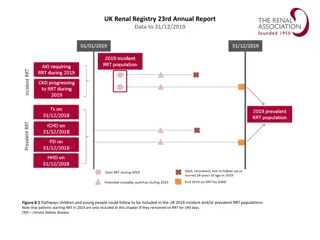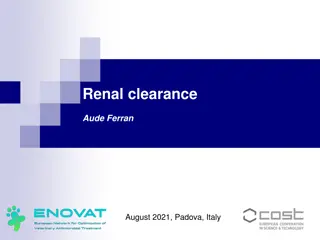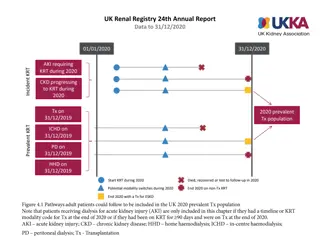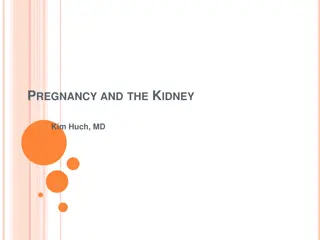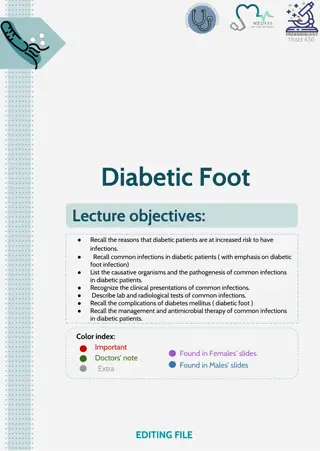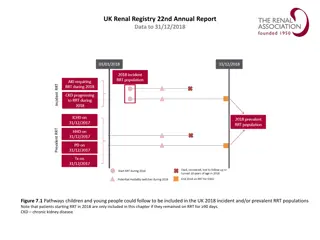Understanding Diabetic Glomerulosclerosis in Renal Disorders
Diabetic glomerulosclerosis is a condition characterized by thickening of the glomerular basement membrane, leading to increased permeability. It belongs to diabetic nephropathy and poses a risk for pyelonephritis. The progression of this disease involves the deposition of proteins in the mesangial space, ultimately resulting in the obliteration of the glomerulus and impairment of renal function. Causes include diabetes, HIV infection, glomerulonephritis, and exposure to harmful chemicals or medications. The mechanism behind diabetic glomerulosclerosis involves defective synthesis of the glomerular basement membrane and mesangial matrix, potentially triggered by hemodynamic changes due to elevated blood glucose levels.
Download Presentation

Please find below an Image/Link to download the presentation.
The content on the website is provided AS IS for your information and personal use only. It may not be sold, licensed, or shared on other websites without obtaining consent from the author. Download presentation by click this link. If you encounter any issues during the download, it is possible that the publisher has removed the file from their server.
E N D
Presentation Transcript
D Disorders of Renal System isorders of Renal System Asst. Prof. Dr. Dalya Basil Hanna
In this lecture. In this lecture . Diabetic Glomerulosclerosis Hypertensive Glomerular Disease Drug Related Nephropathies
Diabetic Glomerulosclerosis Is characterized by thickening of glomerular basement membrane with increased permeability. Diabetic glomerulosclerosis belongs to diabetic nephropathy which includes diabetic glomerulosclerosis, arteriolosclerosis and papillary necrosis, with an increased risk for pyelonephritis. in addition to
Diabetic glomerulosclerosis With time, the mesangial space becomes larger by deposits of proteins, initially diffuse, then nodular. In diffuse glomerulosclerosis there is increase in mesangial matrix with mild proliferation of mesangial cells. In nodular glomerulosclerosis, there is nodular deposition of hyaline in the mesangial protein of the glomerulus. As the sclerotic process progress in the diffuse and nodular glomerulosclerosis, there is complete obliteration of the glomerulus, with impairment of renal function.
Causes of Diabetic glomerulosclerosis Focal segmental glomerulosclerosis (FSGS) is a kidney disease that can lead to glomerulosclerosis. In FSGS, the scarring occurs only in some of the glomeruli. And only part of the individual glomeruli is damaged. Untreated, it can lead to kidney failure. In some cases, kidney failure can occur despite treatment. Diabetes HIV infection Glomerulonephritis, which causes the glomeruli to become inflamed Chemicals and medicines that harm the kidneys can also cause glomerulosclerosis.
Mechanism of Diabetic Glomerulosclerosis Although the mechanism of glomerularchanges in diabetes are uncertain, they are thought to represent enhanced or defective synthesis of the glomerular basement menbrane and mesangial matrix with inappropariate incorporation of glucose into the non cellular components of these glomerularstructures. Alternatively, hemodynamic changes that occur secondary to elevated blood glucose levels may contribute to the initiation and progression of diabetic glomerulosclerosis.
Clinical Manifestation of Diabetic Glomerulosclerosis There are no obvious signs of glomerulosclerosis, but over time, symptoms can develop. These symptoms include: Swelling. Because of fluid retention, you may have swelling in various parts of the body, including: Hands Feet Legs Abdomen Around the eyes The swelling may be painful. It may also cause rapid weight gain.
Clinical Manifestation of Diabetic Glomerulosclerosis Changes in urine. The urine may be foamy or bubbly, caused by proteinuria. Often, glomerulosclerosis is discovered during a routine checkup. Tests during a checkup can reveal an abnormally high protein content in the urine (proteinuria). Or they may show a low level of protein in the blood (hypoproteinemia). Symptoms that often accompany glomerulosclerosis include: High blood pressure High cholesterol
Hypertensive Glomerular Disease Mild to moderate hypertension causes sclerotic changes in renal arterioles and small arteries, referred to as benign nephrosclerosis. The condition has been identified in approximately 15% of persons with benign hypertension (essential hypertension). Hypertensive nephropathy is associated with a number of changes in kidney structure and function.
Manifestations of Hypertensive glomerular disease The kidneys are smaller than normal and are usually affected bilaterally. Narrowing of the arterioles and small arteries, caused by thickening and hyalinization of the vessel walls. As the structures thicken and perfusion diminshes, blood flow to the nephron decreases causing patchy tubular atrophy, interstitial fibrosis, and changes in glomerular structure and function.
Drug Related Nephropathies Drug-related nephropathies involve functional changes in the kidneys that occur after exposure to a drug. Because of their large blood flow and high filtration pressure, the kidneys are exposed to any substance that is in the blood. The kidneys also are active in the metabolic transformation of drugs and therefore are exposed to a number of toxic metabolites.
Drug Related Nephropathies The tolerance to drugs varies with age and depends on: Renal function State of hydration The pH of urine
Mechanism of Drug Related Nephropathies Drugs and toxic substances can damage the kidneys by causing a decreased in blood flow, obstructing urine flow, directly damaging tubulointerstitial structures. Some drugs such as diuretics, high-molecular weight radiocontrast media, the immunosuppressive drugs cyclosporine and tacrolimus, and the nonsteroidal anti- inflammatory drugs (NSAIDs), can cause acute prerenal failure by decreasing renal blood flow. The deleterious effects of the NSAIDs are thought to result from their ability to decrease prostaglandin synthesis and thus decrease renal blood flow.
Mechanism of Drug Related Nephropathies Sulfonamides and vitamin C (due to oxalate crystals) can cause kidney damage by obstructing urinary flow in the tubules. Illicit drug use may cause acute renal failure like cocaine intoxication, the cause is probably multifactorial and involves direct vasoconstriction, altered systemic hemodynamics, and myoglobulin-induced renal failure.
Thank You Thank You
